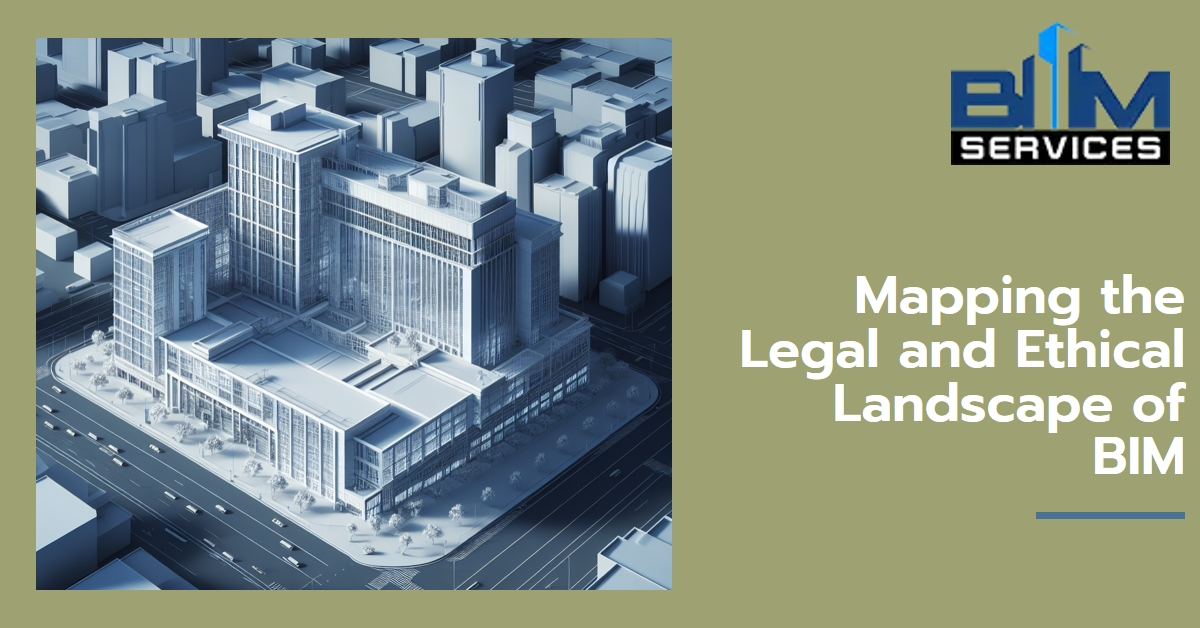Mapping the Legal and Ethical Landscape of BIM

In the dynamic digital landscape, Building Information Modeling (BIM) is rapidly transforming the Architectural and Construction industry, promising unprecedented efficiency, collaboration, and decision-making throughout the entire building lifecycle. According to various surveys, most of the construction firms around the globe are using BIM. While BIM Services offers many benefits, it also raises a number of legal and ethical considerations. These considerations must be carefully addressed in order to minimize risk and ensure the success of BIM projects.
This blog post will explore the pivotal legal and ethical aspects of BIM, highlighting the challenges and opportunities they present for the Architectural and Construction industry.
Table of Contents
Before we dive deep into the legal and ethical aspects, let’s briefly understand what BIM is:
BIM is a digital process used by professionals in the AEC (Architectural, Engineering, and Construction) industry to create and manage data related to both the physical and functional aspects of a building. By bringing together architects, engineers, contractors, and other stakeholders on a collaborative platform, BIM enhances teamwork throughout the project’s lifecycle. This innovative approach encompasses various elements such as 3D modeling, data integration, and information sharing. Ultimately, it results in better decision-making, cost savings, reduced project risks, and many other benefits.
Legal Considerations of BIM
The legal considerations of BIM are complex and important, as BIM can impact a wide range of contractual relationships and project outcomes. Here’s how:
Intellectual Property Rights
BIM models may usually contain copyrighted material or trade secrets. It is important to obtain permission from the copyright or trade secret holder before using their material in a BIM model to avoid legal liability.
Liability and Responsibility
BIM makes it easier for construction teams to work together. However, it can also make it less clear who is responsible for what. If there are design errors or construction defects, it can be hard to figure out who is liable or responsible for that mistake. Contracts and insurance policies should be written to address these issues.
Data Privacy and Security
BIM models contain a wealth of sensitive data, such as project costs, schedules, technical specifications, and more. Therefore, it is important to protect this data from unauthorized access and also ensuring compliance with data privacy regulations is essential. Security measures and policies should not be compromised in any circumstances.
Contractual Agreements
Project stakeholders should coordinate their contracts to ensure BIM compatibility. All parties must clearly define BIM requirements, responsibilities, and expectations, including the required level of detail (LOD) and information (LOI) so that everyone involved in the project has a clear understanding of their roles and responsibilities, and to avoid any misunderstandings or disputes down the road.
Ethical Considerations of BIM
BIM is a powerful tool that can transform the AEC industry. However, with great power comes great responsibility. It is important to be aware of these ethical considerations associated with BIM use so that we can ensure that it is used in a way that is beneficial to all stakeholders.
Transparency
To ensure that everyone is on the same page and that decisions are made based on the best available information, BIM models should be shared openly and transparently among all project stakeholders.
Data Accuracy and Quality
BIM models should be accurate and complete. Inaccurate or incomplete models can lead to safety hazards, financial losses, and delays. Therefore, implementing ethical practice necessitates the verification and validation of data used in BIM models.
Sustainability
BIM can be used to promote sustainable design and construction practices as it plays a vital role. However, it is important to use BIM responsibly and to avoid creating unnecessary environmental impacts that can increase the carbon footprint of the project, generate electronic waste, and more.
Workforce training
It is necessary that all the project participants are trained thoroughly on how to use BIM tools and methodologies effectively, which promotes ethical collaboration and reduces the risk of errors.
Community engagement
When we talk about the community, BIM can be used to engage and solicit feedback on projects. This helps to ensure that projects meet the needs of the communities they impact on.
Conclusion:
BIM is a revolutionary technology that is transforming the AEC industry. It offers unprecedented opportunities for improved efficiency, collaboration, and decision-making throughout the entire building lifecycle. However, by carefully considering and addressing these legal and ethical considerations, AEC professionals can leverage the full potential of BIM to deliver better projects, faster, and more cost-effectively.
Tesla Outsourcing Services is a leading provider of BIM Outsourcing Services with clients around the world with over a decade of experience. We specialize in providing a wide range of BIM Solutions like BIM Modeling, Point to Cloud BIM, BIM Clash Detection, BIM Coordination, and more. We are committed to providing high-quality, cost-effective solutions that help you in achieving your project goals.